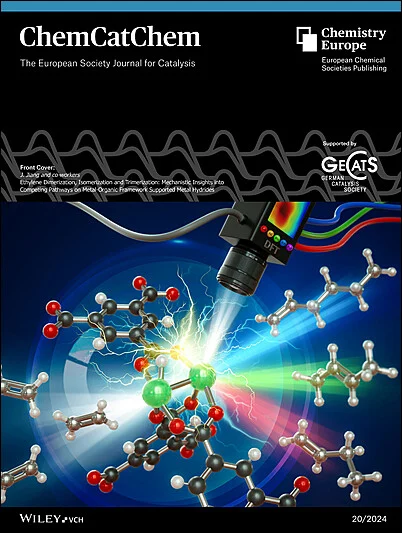Efficient Ru/Y2O3 Catalyst Derived from Ru Nanoparticles on Yttrium Carbonate for Production of Hydrogen from Ammonia Decomposition
IF 3.8
3区 化学
Q2 CHEMISTRY, PHYSICAL
引用次数: 0
Abstract
Hydrogen production from decomposition of ammonia is one of the promising methods to solve the problem of hydrogen storage and transportation. Currently, ruthenium‐based catalysts are widely recognized as highly active catalysts for ammonia decomposition reaction. Here, Ru nanoparticles (NPs) on yttrium oxide derived from yttrium carbonate precursor (c‐Y2O3) was successfully prepared by impregnation method. A hydrogen production rate up to 31.5 mmol gcat−1 min−1 can be obtained over the 5% Ru/c‐Y2O3 catalyst at 450 °C with a weight hour space velocity (WHSV) of 30000 mL gcat−1 h−1, and the activity is stable during a test period of 120 hours. Characterization results reveal that high metal dispersion of Ru NPs, strong metal‐support interaction, high concentration of oxygen vacancies and suitable basicity of Ru/c‐Y2O3 catalyst all have a strong influence on the catalytic performance in ammonia decomposition. NH3 temperature‐programmed surface reaction (NH3‐TPSR) results indicate that a strong NH3 adsorption activation and binding desorption of nitrogen ability on the surface of Ru/c‐Y2O3 catalysts are also beneficial for the high activity. These results provide a reference for the design of efficient Ru‐based ammonia decomposition catalysts for hydrogen production by tuning the precursor of Y2O3 support.由碳酸钇上的 Ru 纳米粒子衍生的高效 Ru/Y2O3 催化剂用于利用氨分解制取氢气
利用氨分解制氢是解决氢储存和运输问题的可行方法之一。目前,钌基催化剂被广泛认为是氨分解反应的高活性催化剂。本文采用浸渍法成功制备了以碳酸钇为前驱体的氧化钇(c-Y2O3)上的 Ru 纳米粒子(NPs)。在 450 °C 温度下,5% Ru/c-Y2O3 催化剂的制氢速率可达 31.5 mmol gcat-1 min-1,重量小时空间速度(WHSV)为 30000 mL gcat-1 h-1,并且在 120 小时的测试期间活性稳定。表征结果表明,Ru NPs 的高金属分散度、金属与支撑物的强相互作用、高浓度的氧空位以及 Ru/c-Y2O3 催化剂合适的碱性都对氨分解催化性能有很大影响。NH3 温度编程表面反应(NH3-TPSR)结果表明,Ru/c-Y2O3 催化剂表面强大的 NH3 吸附活化和结合解吸氮能力也有利于催化剂的高活性。这些结果为通过调整 Y2O3 载体的前驱体设计高效的 Ru 基氨分解制氢催化剂提供了参考。
本文章由计算机程序翻译,如有差异,请以英文原文为准。
求助全文
约1分钟内获得全文
求助全文
来源期刊

ChemCatChem
化学-物理化学
CiteScore
8.10
自引率
4.40%
发文量
511
审稿时长
1.3 months
期刊介绍:
With an impact factor of 4.495 (2018), ChemCatChem is one of the premier journals in the field of catalysis. The journal provides primary research papers and critical secondary information on heterogeneous, homogeneous and bio- and nanocatalysis. The journal is well placed to strengthen cross-communication within between these communities. Its authors and readers come from academia, the chemical industry, and government laboratories across the world. It is published on behalf of Chemistry Europe, an association of 16 European chemical societies, and is supported by the German Catalysis Society.
 求助内容:
求助内容: 应助结果提醒方式:
应助结果提醒方式:


